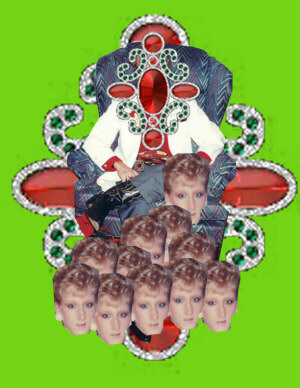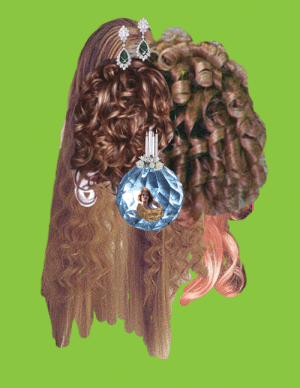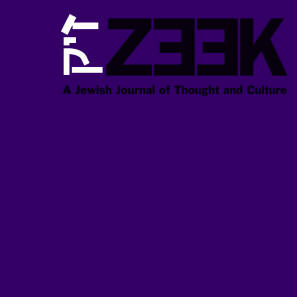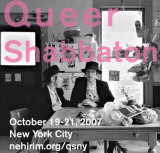 March 06
March 06
Wrestling with Esther: Purim Spiels, Gender, and Political Dissidence
Emily Nepon

1. A Drag King’s Bar Mitzvah
In 1999 I won the Philadelphia Drag King contest with my portrayal of metal-head bar mitzvah boy Ben Hesherman, whose speech broke into a rendition of “Breaking the Law” by Judas Priest. Onstage, I told the crowd, “I don’t want to grow up be a man like my father or the rabbi or the Israeli heads-of-state. I want to be like David Lee Roth and Gene Simmons of KISS! Members of my community, friends of my grandparents, I hope you’ll support me. I don’t want to learn Hebrew, I want to learn to rock!” I stripped off a too-big suit to uncover leather pants and a sleeveless Metallica T-Shirt. Someone threw me a plastic toy guitar, and a star was born.
The truth is, at five feet tall, with short hair and chubby boyish looks, the character wasn’t a stretch: my family often jokes about how much I look like my dad at his bar mitzvah. The next year at the contest, I brought Hesherman back for a scandalous performance involving a rabbi, a rocker drag queen, tefillin, and some honey (so that the Torah should be sweet to me). The soundtrack was KISS’s “Charisma.” Some might find these performances disrespectful and sacrilegious, but for me, creating and performing as Ben Hesherman enabled me to come out to my queer community about my Jewishness in a celebratory and sexy way. At the same time, performing an explicitly Jewish masculinity provided a space for me to connect and celebrate with other queer Jews, offering a language for communicating my gender-queerness in a way that my Jewish community (including my parents) could recognize.
Somewhere in the haze of the glittery King’s crown, cross-dressing, and sweet treats I realized that my performances were inspired by memories of childhood Purim celebrations. As a child, I attended Purim parties dressed up as Esther in my grandmother’s costume jewelry and done up with blush and lipstick, which my hippie mother rarely used. The glamour of the Purim celebration was like a second Halloween to me. As a teenager, I gravitated to identifying with the character of Vashti as an icon of feminist resistance. At the time, my early queerness gave me a feeling of vulnerability, a sense that I could be thrown out of the community for being true to myself, as the King had exiled Vashti.
My experience of Purim as an opportunity for boundary-crossing transgression is nothing new; in fact it’s a very old tradition. The oldest surviving text of Yiddish Purim parody-plays (called Purimspiels) is a manuscript from 1697 known as the “Achashverosh-shpiel,” a play considered so vulgar at the time that it was burned by the government of Frankfort, Germany. In 1728, the government of Hamburg banned the performance of Purimspiels entirely. Today, purimspiels are common in yeshivas and religious communities. But the celebrations have also been reclaimed in recent years by Jewish feminists, queers, and progressives of all types, in part because of the possible feminist readings of the story and in part because of the topsy-turvy carnivalesque nature of some Purim traditions. These groups, marginalized by the mainstream Jewish community, are building on the rich history of Purim theater to create powerful spectacles and performances that critique, amplify, and challenge the politics of our times, the Jewish community, and the Megillah’s story itself.

2. The Shadow of Marginalization
A quick refresher on the Book of Esther: Ahasueros, the King of Persia, sends away his disobedient first wife Vashti, who refused to dance naked for the king and his guests. He holds a pageant for a new wife. A young Jewess named Esther (Hebrew name: Hadassah) enters at the urging of her uncle Mordechai and wins, having kept her Judaism a secret. Later, Mordechai uncovers a plot to kill the king by two eunuch guards. Through Esther, he alerts the king and foils the plot. Mordechai’s good deed is then recorded in the royal book of chronicles. Soon after, Mordechai refuses to bow to the King’s assistant Haman, stating that, as a Jew, he will not bow before a man. Angered and incensed at Mordechai's being honored for saving the king's life, Haman arranges to kill Mordechai and all the Jews in Ahasueros’s empire, with the blessing of the king. After a period of fasting and prayer, Esther saves the Jews by outing herself (as a Jew) to the king, who, while not rescinding his decree, allows the Jews to arm and defend themselves. Everything turns upside down: the Jews are victorious, instead of being annihilated; Mordechai is given the honored role that Haman had held; and Haman is hanged on the gallows intended for Mordechai.
That’s where the storytelling usually ends in Sunday school classes and Purim parties. But the Megillah actually goes on to describe a massacre of over 75,500 Persians, as well as Haman and his ten sons. The story of Esther and Mordechai’s heroism on behalf of all Jews is a great reason to celebrate, but how can we wrestle with the implications of the end of the story, the brutal vengeance-lust of the Jewish people, if we don’t even talk about that part of the scroll?
At a recent Barnard College conference on “Jewish Women Changing America,” I asked performance artist/drag queen Amichai Lau-Levi (presenting in chararacter as Rebbitzin Hadassah Gross) to talk about the work s/he’s done to reclaim and reinterpret Purim in productions such as “ Esther Don’t Preach: A Purim kaBLAHBLAH Bash!” As the Rebbitzin, Lau-Levi reflected that while we are all starving for ritual on our own terms, Purim is also about the shadow of genocide, marginalization, and hating “the other,” and reminded the audience of the events of Purim 1994. That year, Baruch Goldstein massacred 29 Muslims, and injured a hundred more, who were praying at the Ibrahimi Mosque/Cave of the Patriarchs in Hebron. Survivors of the massacre killed Goldstein, a member of the Jewish Defense League, and an IDF doctor. Israeli right-wing extremists see Goldstein as a holy martyr, claiming that he pre-empted the mass murder of Jews by Arabs. Witness the message on Goldstein’s gravesite:
Here lies the saint, Dr. Baruch Kappel Goldstein, blessed be the memory of the righteous and holy man, may the Lord avenge his blood, who devoted his soul to the Jews, Jewish religion and Jewish land. His hands are innocent and his heart is pure. He was killed as a martyr of God on the 14th of Adar, Purim, in the year 5754 (1994).
Those who eulogized Baruch Goldstein remembered his actions as a kind of “pre-emptive strike” against those who wish to kill the Jews. Did Goldstein see himself as a modern Mordechai? The 1994 massacre makes it clear that those of us who wish to celebrate Esther,Vashti, or Mordechai’s resistance to unjust authority must also deal seriously with the alternate Purim-interpretation of heroic vengeance and security-through-brutality, values that influence not only Baruch Goldstein and his supporters but also our own Israeli and American governments. By avoiding the end of the story, Purim revelers risk giving uncritical license to the fundamentalism and xenophobia found in the text.
In reality, the Purim story may never have happened. Scholars believe that King Ahasueros may have been the Persian king, Khshayarsha, whom the Greeks called Xerxes, and who ruled from 486 to 465 B.C.E. in Shushan, the capital Persian city. The descriptions of Ahasueros’ giant kingdom, which spanned 127 countries from India to Ethiopia, match the size of the Persian Empire under Xerxes, who was also known for his big fancy feasts and parties. On the other hand, no historic records verify the Megillah’s story, which has much in common with ancient romances, fairy tales, and other fantastic literature. As Rabbi Arthur Waskow writes, “Most Jews today understand the whole story of Esther not as an historical chronicle but as a novel.”










